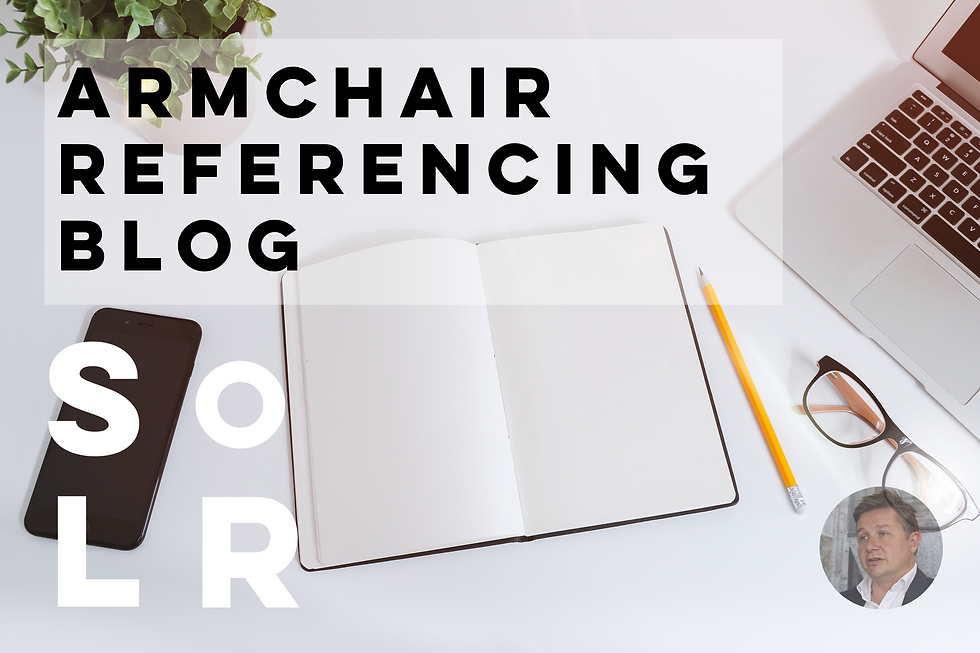Armchair land referencing #7
- Ashley Parry Jones

- Jan 6, 2023
- 3 min read

To identify people and places we use a series of unique references or identifiers. Some of these are automatically assigned in our GIS databases: each land parcel has a unique plot number assigned – eventually replaced by a book of reference number or equivalent.
However, there are other everyday unique references that we use that we perhaps take for granted. Not all of us have unique names (although I think I might…). I recall once working on a cross-border road scheme linking Northern Ireland and the Republic of Ireland and referencing two unrelated gentlemen from the same townland (village) who rejoiced in exactly the same name. They lived in different houses but confusingly also had exactly the same postal addresses, as the streets had no name – just as the (Irish) song states! Both told me not to worry about their letters and notices as their local postman always opened their post and worked out which one of them it was for. The reason they had the same address was because the Irish postal system had not then availed itself of some of mechanisms commonplace elsewhere. The first records of house numbering is from 1512 in Paris. In Britain urban houses didn’t have to have numbers until The Stamp Act of 1765 but some areas started earlier: Lincoln’s Inn, opposite WSP’s Chancery Lane office, was reputedly the first. Prior to that houses just had descriptive names. Now we also have postcodes across the UK - 1.7 million of them. The national system we have today was trialled in 1959 and the gradual introduction finished in 1974. I’m just old enough to remember postcodes being introduced where I was brought up in North Wales and recall my grandmother being most put out when she had to update her stationery, having previously had a full address that contained no numbers and just three different words. Ireland’s impenetrably complex postcodes were only provided to all addresses in 2015 (impressively a unique code for every address), making Ireland the last developed country to have this address system. Presumably that postman no longer needs to read the mail.
Road numbers are also coded, with some highway authorities going beyond numbering just the A and B roads and venturing down to the Cs or even further, plus providing (not

necessarily unique) numbers or other codes to public footpaths, bridleways, etc. Have you ever noticed the pattern whereby road numbers are allocated nationally? London is as the centre of a clockface with the A1 running north at 12 o’clock. England and Wales are then divided into sectors with the A and B roads, etc plus the motorways starting with the number corresponding to that sector. East of the A1 all the roads start with 1, and then going clockwise, after the A2 they start with 2, going right round with the A3, A4, A5, A6 and back to the A1. This explains why Junction 1 of the M25 is in Kent. Scotland’s sequence picks up with the A7 and finishes the series with the 9s. N Ireland - and the Isle of Man - both start again with their own A1s.
Finally, we also use unique telephone numbers to provide, or at least confirm, identities. We can check that a named party is associated with an address by cross-checking against directory enquiries. This data is now provided electronically via QAS or other means but this wasn’t always the case. Once these checks were only possible by calling directory enquiries. From private line calls you could make three enquiries at a time and the calls were charged. I discovered that making these calls from a public telephone was free and, better still, permitted 10 numbers to be queried at a time, making the whole process quicker. I once spent two whole days in a telephone box off Trafalgar Square verifying every name and address in the book of reference I was preparing for a project and ended up on first name terms with a few of the operators I was randomly connected to. The phone box on Cockspur Street is still there and I involuntarily pale when I pass it...
Do you know what ‘special category’ planning restriction may be assumed just from the appearance of a phone box? Answer next time, when we shall consider phone boxes more closely as well as the land referencing clues other everyday items of street furniture provide.
This article is written by Ashley Parry Jones, Director – Planning, WSP. The opinions expressed are those of the author and do not purport to reflect the opinions or views of WSP or SoLR or its members. The information provided does not and is not intended to constitute legal advice and instead is offered for general purposes only. It does not constitute the most up to date legal information. Any links and references provided are for the readers’ convenience only and do not constitute a recommendation of those sources.




Comments